
20 Jun Blue Wave
By Lisa Ellis
I’ve always been drawn to the colour blue. You’d probably agree that it’s both calming and serene. And who wouldn’t want those qualities in a garden- particularly given the catastrophic events of recent months.
I’ve yet to meet a client who doesn’t like the idea of blue in their garden. Because when it comes to blue- what is there not to like? I think of coolness and timelessness. Delft blue Dutch china and old school Wedgewood settings. Blue hydrangeas and potted hyacinths. Faded denim jeans. Holidays and azure oceans.
Several years ago I read a fascinating book titled “Drunk Tank Pink” by psychologist Adam Alter. He wrote about the use of different colours in social experiments- some planned and others accidental- and the profound effect that colour can have on us. He touched on “The Blue Phenonemon” which refers to the (almost) universal appeal of the colour blue- a colour that has a worldwide popularity greater than any other single colour.
This may all seem interesting, but to my eye there are in fact few authentically blue flowering plants. I’ve considered this often but none moreso than recently: a new client’s design brief was for the design of a garden featuring blue flowers. And there were not to be any purple, lavender or mauve flowering plants. Inevitably, this got me thinking…
Blue, purple or lilac?
Sure, there’s a great number of plants that may be described as blue- and even have the word “blue” in the cultivated variety assigned to the plan. For example Agastache ‘Blue Boa’ suggests an ostentatiously blue feathery showgirl of a plant- but in actual fact the flowers take on a pink/lavender appearance reminding me of the shot silk so big in the eighties for formal dresses (guilty on all counts).
It’s a similar deal with the form of Australian native- Boronia ‘Blue Waves’- I see lilac purple only! So what that means is that my perception of colour may well be different to others’ views – including people who named this plant in the first place.
You only need to google Agastache ‘Blue Fortune’ to discover that half the images look undeniably purple, whilst others seem genuinely and undeniably blue. Even if some plants are incorrectly labelled -and this happens more often than you may think- it really is all quite confusing.
There is also the scientific notion of “colour constancy” which suggests that past visual experiences and recollections of colour can strongly shape our perceptions of colour today- even under completely different conditions. So that means that if you’ve previously noted a flower as being blue, you’ll continue to believe that flower is blue even if everyone else is adamant it’s purple!
It also seems that the time of day and season, and the degree of direct sunlight will play a role in how we might differentiate between blue and purple. Some flowers tend to vacillate between the two more than others- and some seem more convincingly blue most of the time. When the sun fully drenches a floral display it seems- at least to my eye- that purples can at times have the ability to be more prevalent and powerful than blues- save for just a short list of species. I also think that cobalt blue flowers can be in no doubt of their colour in the shade. I’d also suggest that flowers and foliage that sit adjacent to the flowers will also help to inform our perception of that specific floral colour.
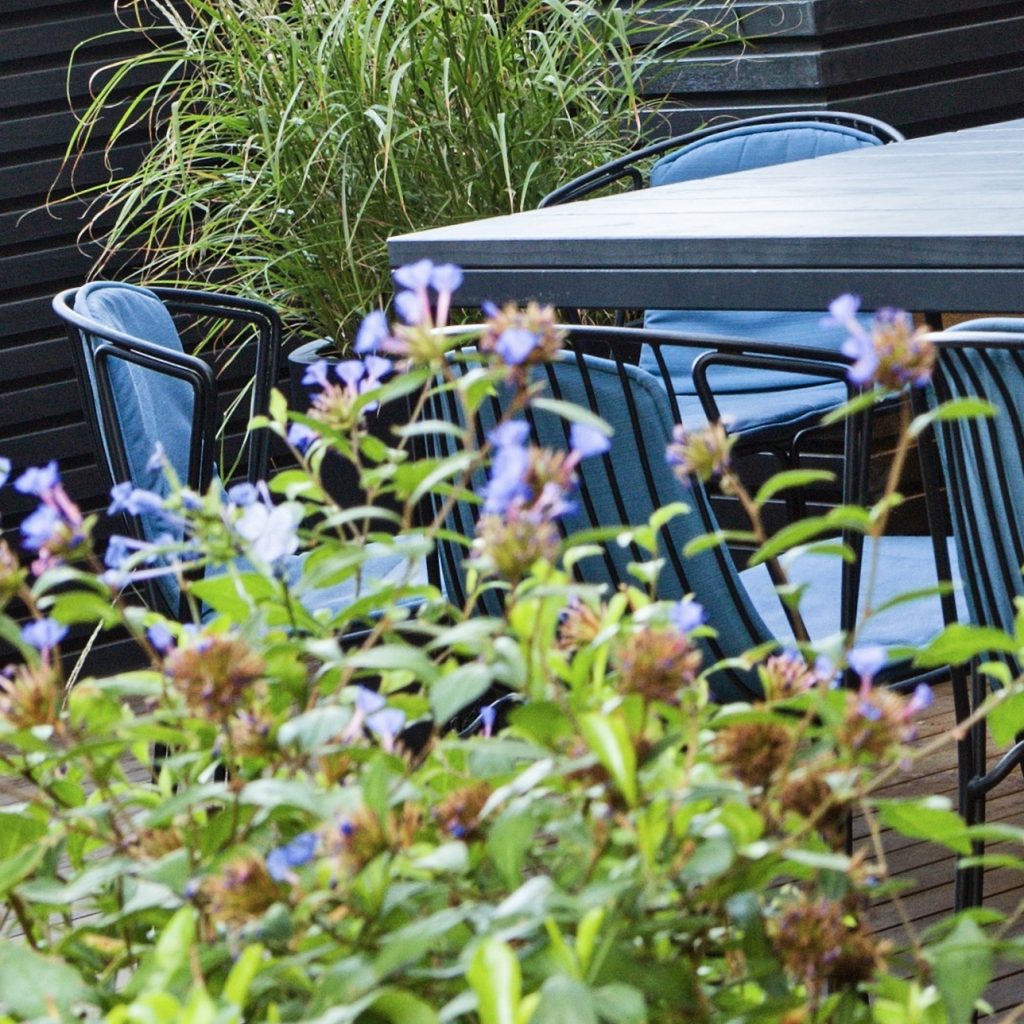
Chinese Plumbago (Ceratostigma willmottianum) shown in a garden. Soft furnishings accentuate the blue flowers. Design by Lisa Ellis Gardens
And that reminds me about the first time I learned about colour at school. It was a revelation to learn that colours are not actually ‘inherent’ in objects- but it’s the light waves that bounce off objects that enable us to “read” or perceive colour. So that means that flower colour is not real. And of course, your perception may be slightly different to mine.
But enough of this science, you’re thinking. You’re only here for the flowers.
The Blue Checklist
The list below is not exhaustive but simply a personal list of plants that bear more authentically blue flowers than other plants. Even while compiling this list I doubted myself on several inclusions- so I’m happy to stand corrected! And I’d be very happy to receive more suggestions.
Keep in mind that I’ve not even touched on blue foliage or blue coloured berries…they are deserving of an article of their own.
Are any of your favourites included below?
- Agapanthus ‘Guilfoyle’
- Agapanthus ‘Taw Valley’
- Agapanthus ‘Isis’
- Ajuga Caitlin’s Giant
- Billardiera heterophylla Blue Form
- Caryopteris cladulensis ‘Heavenly Blue’
- Ceanothus ‘Gloire de Versailles’
- Ceanothus ‘Trewithen Blue’
- Ceanothus ‘Yankee Point’
- Ceratostigma griffithii
- Ceratostigma plumbaginoides
- Ceratostigma willmottianum
- Convolvulus ‘New Blue Moon’
- Corydalis ‘Pere David’
- Delphinium ‘Blue Sensation’
- Dichroa versicolor
- Echinops ‘Veitchs Blue’
- Eryngium ‘Tetra Petra’
- Felicia amelloides
- Geranium ‘Jolly Bee’
- Iris germanica bearded irises selected cultivars
- Lechenalutia biloba
- Omphaolodes ‘Cherry Ingram’
- Orthrosanthrus multiflorus
- Plumbago auriculata
- Pulmonaria ‘Blue Ensign’
- Rosmarinus ‘Blue Lagoon’
- Salvia ‘African Skies’
- Salvia ‘Marine Blue’
- Salvia azurea
- Scilla peruviana
- Symphytum grandiflora ‘Hidcote Blue’
- Thunbergia grandiflora
- Wahlbergia ‘Blue Mist’
Plant profiles
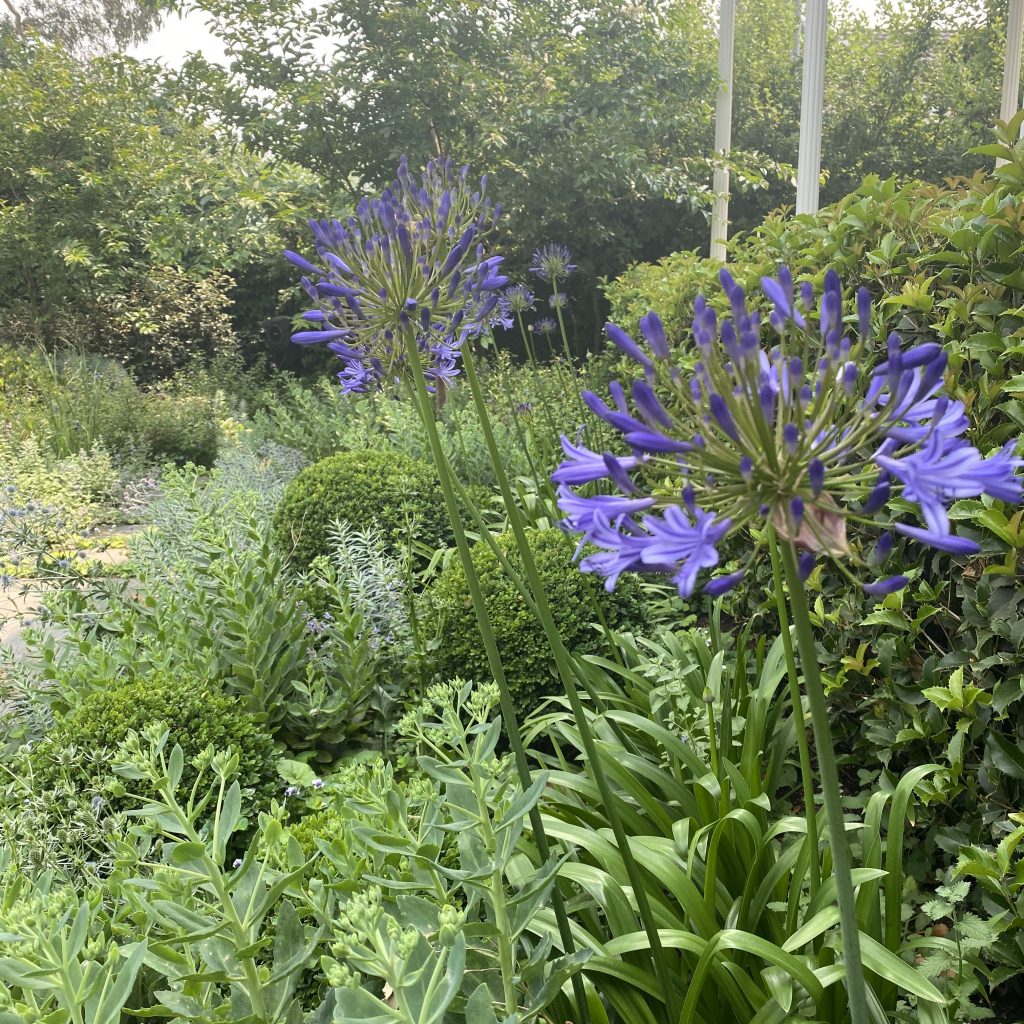
Agapanthus ‘Guilfoyle’- how fitting that a statuesque and upright dark blue agapanthus is named after William Guilfoyle. This form is fabulously statuesque and the stiff upright stems hold the spectacular spherical blue flowers from say December through to March.
It’s important to not tar all agapanthus with the same brush. Some agapanthus are extremely weedy and damaging to the environment. Yet there are some forms and cultivated varieties that are sterile (they set no no seed or very low seed) and should be considered for the ability to perform brilliantly in tough conditions without much regard for soil or water.
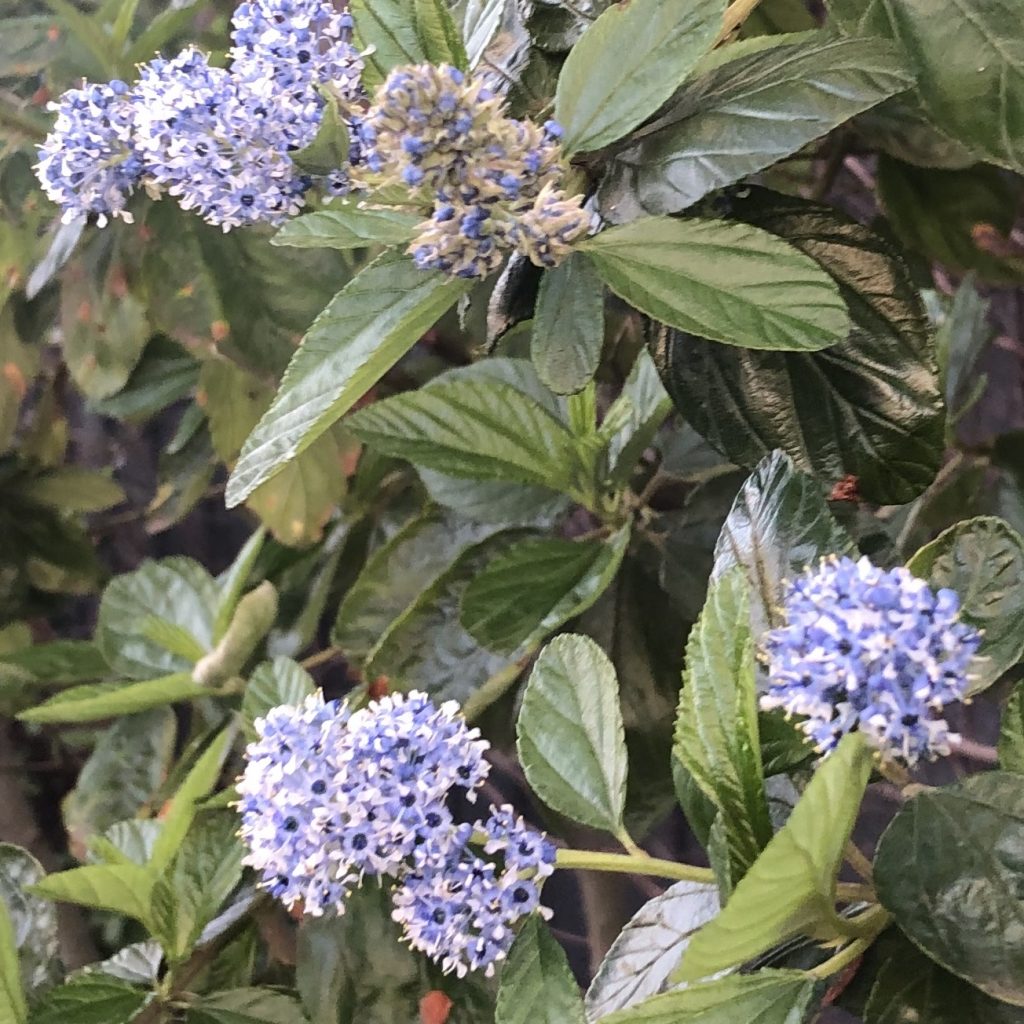
Ceanothus ‘Trewithen Blue’– this is a wonderful large shrub which belongs to a fairly tough bunch called “Californian lilacs”. Not in fact true lilacs but indeed bred from tough species native to California. Californian lilacs will burst into flower in early spring and well worth considering for their hardiness and flowers.
According to one of our clients, the flowers of ‘Trewithen Blue’ resemble blue liquorice all-sorts. If this confectionary appeals then you might consider! This form is terrific when pruned to form a small tree to 3-4 metres in height with underplanting.
Ceanothus ‘Yankee Point’possesses darker green foliage and blue flowers and prolific floral display that might have you think that the plants will keel over from the weight of the blooms. There is also Ceanothus ‘Gloire de Versailles’though I tend to think that is more mauve than blue- although that may simply be when I’ve observed the flowers before they are fully open.
Ceratostigma species- these plants are so deserving of attention that a future blog post will be dedicated to them. In fact when writing this list, it was Ceratostigma willmottianum that first came to mind. Another blog post will follow on this soon.
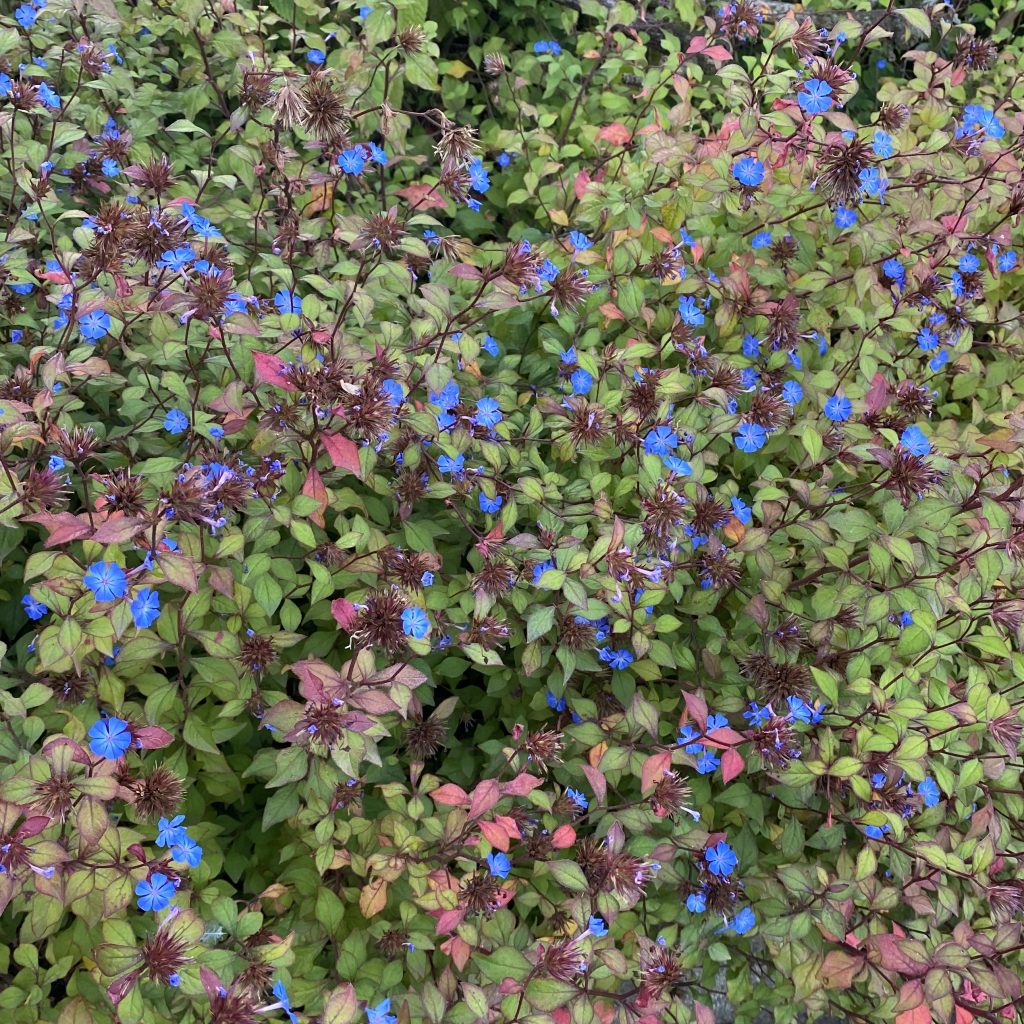
Ceratostigma willmottianum- extraordinarily useful, this plant is a ‘quiet achiever’ that brings ‘true blue’ flowers to the garden. It also seems quite soft while also having presence, and sets off other plants around it. This image is of the species colouring up in a garden in mid autumn.
Corydalis ‘Pere David’– This plant has the most fetching dainty aquamarine flowers and delicate foliage that you could imagine. It’s a gorgeous perennial that requires shade and regular moisture. Your efforts to grow this will deliver the lotto in spring! This form is said to be more heat resistant than some other cultivars. I also note that the rare form Corydalis ‘Porcelain Blue’ is currently available at Lambley Nursery- order some now for planting in a pot for some spring joy.
The straight species C. flexuosa features in the excellent book “Flora of the Silk Road” by botanists Gardner & Gardner- a spectacular book crammed full of images of plants in their native habitats. This is a book worth having: it’s jaw dropping to see so many beautiful and seemingly delicate species growing naturally in such harsh landscapes.
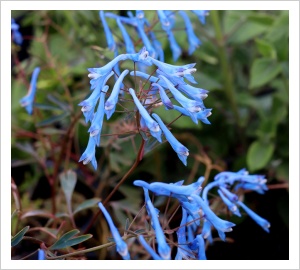
Corydalis ‘Porcelain Blue’ is available from Lambley Nursery. (Photo supplied by Lambley).
Dichroa febrifuga- Often called the “evergreen hydrangea” this is a lovely shrub that is perfect for mid storey placement and perfect beneath deciduous trees. According to Stearn’s Dictionary, the species “febrifuga” means fever-dispelling but I suggest no one experiments medicinally with this plant even in these virus-tainted times. Native to the Himalayas, the plant features blue and pink flowers on the same shrub. And the blue flower heads do look all the more blue when poised alongside their pink counterparts.
Echinops retro ‘Veitch’s Blue’- I just adore this Globe Thistle for the striking form of the blue baubles held above foliage. Generally speaking, in landscape design visual drama can be achieved through pairing contrasting shapes- and this plant has all the credentials for contrast.
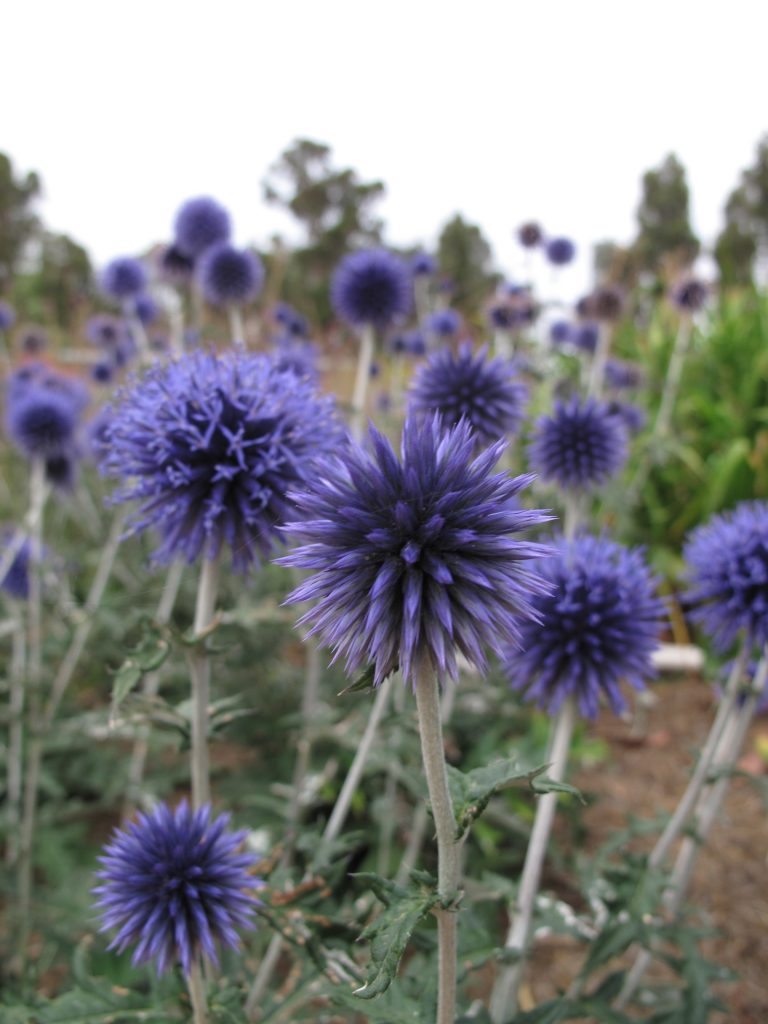
Consider how swathes or concerted accents of this plant could create pearl-clutching moments in your own garden. It does need full sun. This is a particularly great form as it is a repeat flowerer – and pairs perfectly with so many other perennials. In my experience this will not perform particularly well if the soil is overly fertile; it will jump out of the ground too quickly and then want to fall over.
Eryngium ‘Tetra Petra’- this is a delicious metallic lilac blue flowering sea holly. When some people see Eryngiums they see thistles. I suggest they need to take a second look! When it comes to sea holly, sandy loam and sun are perfect for this plant. As it is coastal tolerant it can also handle wind and therefore perfect contenders for rooftop gardens too. Find image of this plant further below.
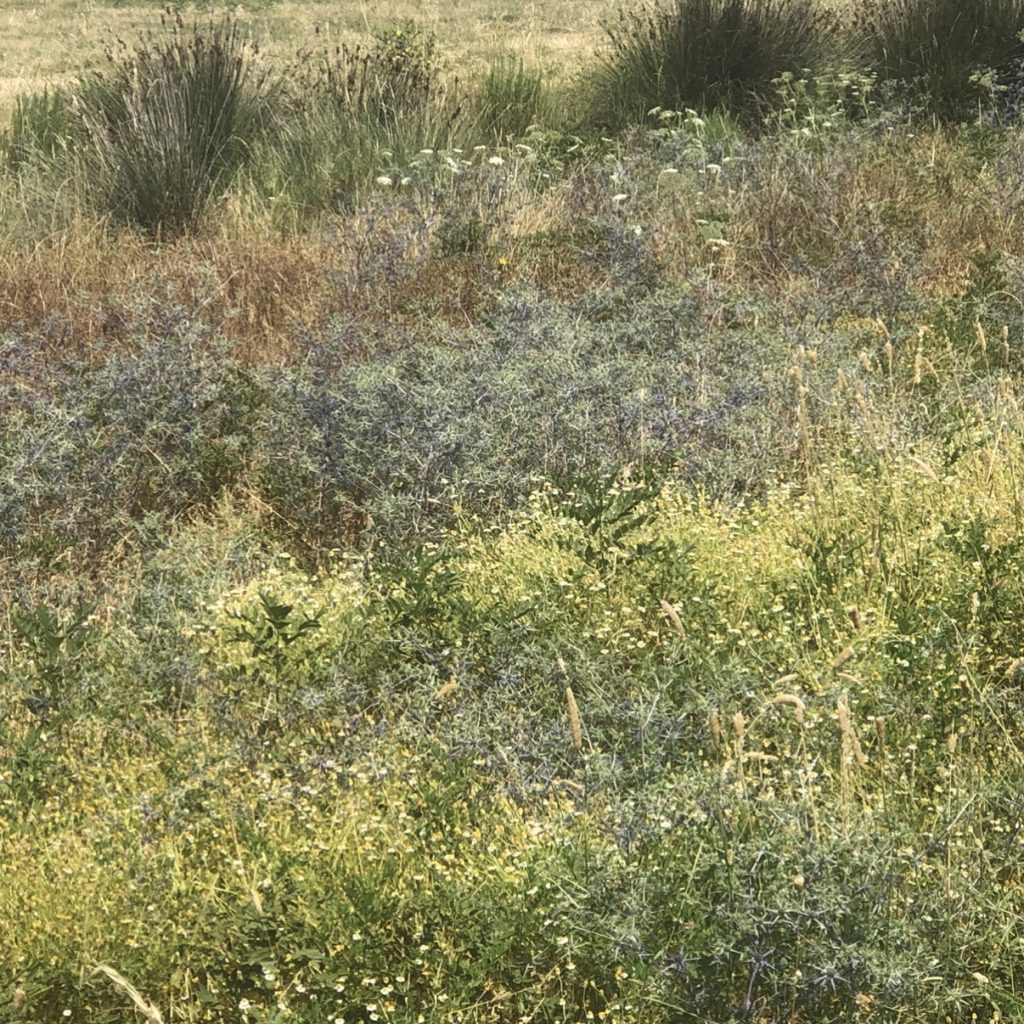
Here is an image taken in June 2019 on the Greek island of Kefalonia showing a swathe of shy blue metallic sea holly- Eryngium maritimum. The sun was so blindingly bright when I took this photo that much of the colour was washed out.
Geranium ‘Jolly Bee’- This is the most magnanimous of botanical gems. It’s a plant that will keep giving and giving flowers for months. Plant it in pots, on the edge of low retainer walls, as a low storey at the front of garden beds. Don’t confuse this form with Geranium ‘Rozanne’- which is also a brilliant plant- though the flowers of the latter have a white throat. Geranium ‘Jolly Bee’ is said to be longer flowering than ‘Rozanne’. Big tick all around.
Omphalodes ‘Cherry Ingram‘- In many gardens that we’ve designed we’ve crammed in a mooring of this plant as we know the amount of joy that this will deliver. It’s a plant that’s sure to attract attention and comments simply due to the intensity of the blue flowers. I remember seeing a small swooning audience in front of a clump at the main entrance to Sissinghurst Castle garden several years ago. An evergreen perennial that can handle a good amount of shade, it opens up into beautiful clean blue flowers in early spring.
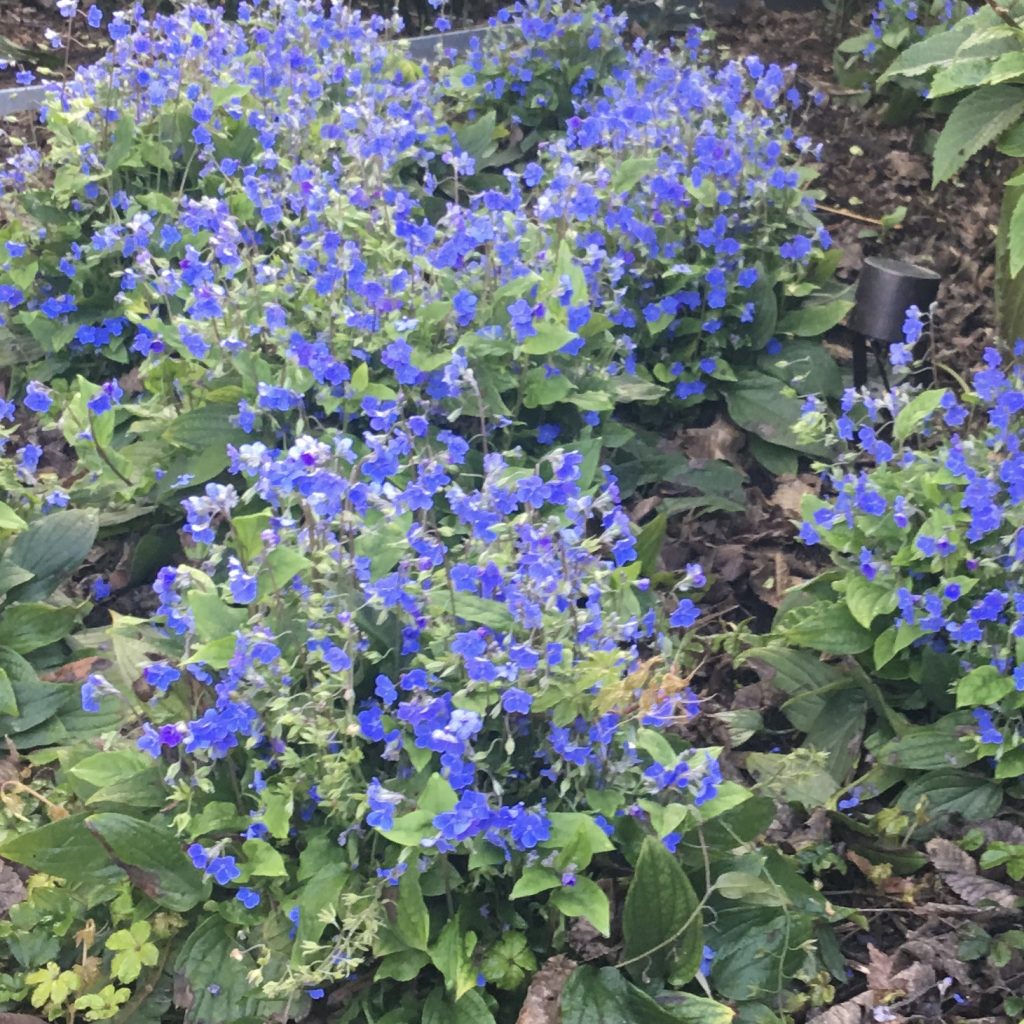
Omphalodes ‘Cherry Ingram’- we have ordered this plant many times from wholesale production nursery Antique Perennials which is opening a retail arm in spring. So make sure you hot foot your way out to Kinglake later in the year to get your Cherry Ingrams on.
Orthrosanthrus multiflorus – Morning Flag Lily- this is an Australian native plant with elegant pressed iris-like foliage and blue flowers in spring. It’s a plant that will be at home equally in a planting of exotics as much as natives. Drifts of this plant in quantities of say, five to nine plants can be very effective in a garden. If this was a horse racing guide, the final edict would be “do not overlook”.
Plumbago auriculata– this plant delivers on so many fronts it just has to be included here. Strangely enough I’ve found many people are not a fan- but that is probably just because it is “common”. When used well, this plant can be nothing short of outstanding. It will cover banks and rockeries, will not be fussed about soil quality and can handle considerable periods of drought. (We have used the deeper blue form ‘Royal Cape’ on a number of occasions but are struggling to find a nursery who grows it. Please get in touch if that is you!)
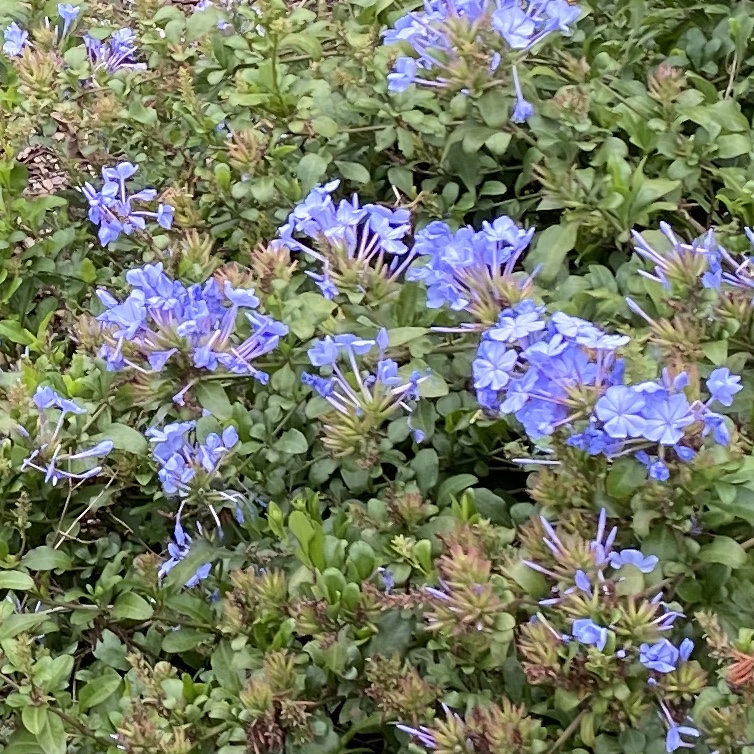
Plumbago auriculata will flower continuously for months on end. Consider using this in Greek terracotta urns for unstructured long flowering displays- place an urn at the front door or multiples in the garden or poolside. Whilst the white form ‘Alba’ is available, it’s the blue form that just gets me every time.
Salvia azurea- as its name suggests this salvia has sky blue flowers of an intensity that is hard to believe. Native to northern America this plant is as tough as tough gets. It loves to perform in full baking sun. To be honest, it’s not a show stopper until it flowers…and then, well, nothing else really matters. It’s an unbelievably beautiful haze of clear blue flowers that comes into its own when many other plants are eyeing off retirement for the season.
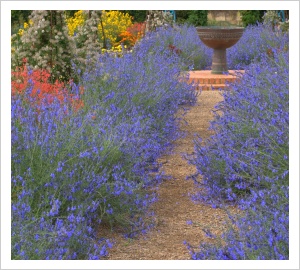
It does need room to express its form so I’d suggest a minimum of 80cm width right up to 1m as its rambling nature will mean it becomes entangled with other plants to create an ill defined bird’s nest (this author speaks from personal experience!) If you are interested in adding this brilliantly tough plant to your garden, look at this for inspiration. I say no more.
Photo: Lambley Nursery.

Scilla peruviana- this is a heavenly plant that I had seen a number of times but the first time en masse at Dame Elisabeth Murdoch’s Cruden Farm more than 20 years ago. Despite the species ‘peruviana’ suggesting it is from Peru, it is in fact native to north western Europe.
Blue Heaven: tough and sun loving
Below is a collection of favoured blue flowering plants that thrive in sun.
Plants shown top to bottom: 1. Plumbago auriculata at Royal Botanic Gardens Melbourne; 2. Felicia amelloides at Como Garden; 3. Eryngium bougatii ‘Oxford Blue’ photographed at Lambley Nursery; 4. Echium candicans; 5. Geranium ‘Jolly Bee’ (photograph supplied by Antique Perennials); 6. Salvia ‘African Skies’ (photograph supplied by Antique Perennials); 7. Ceratostigma griffithii ; 8. Caryopeteris x clandonensis ‘Heavenly Blue’ paired with Miscanthus transmorrisonensis (design Lisa Ellis Gardens); 9. Eryngium ‘Tetra Petra’ (photograph supplied by Antique Perennials).
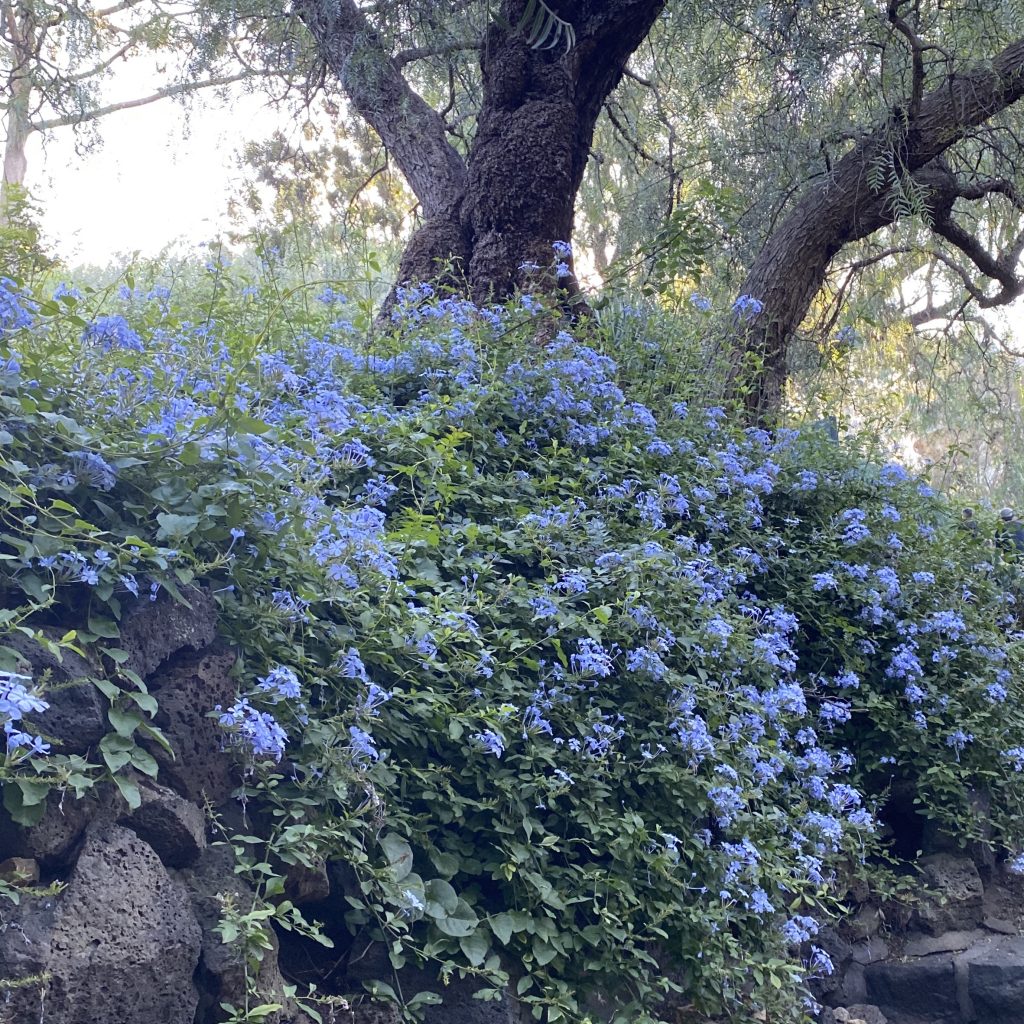
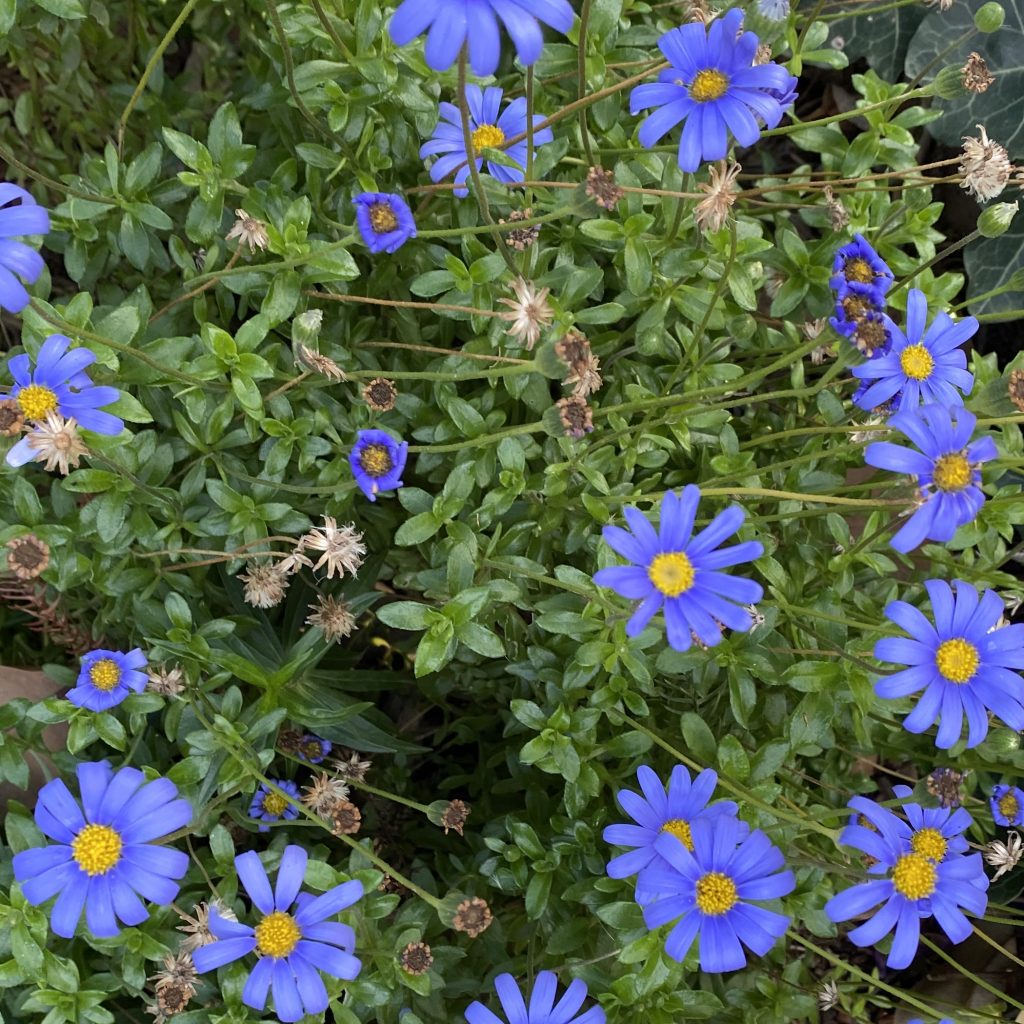
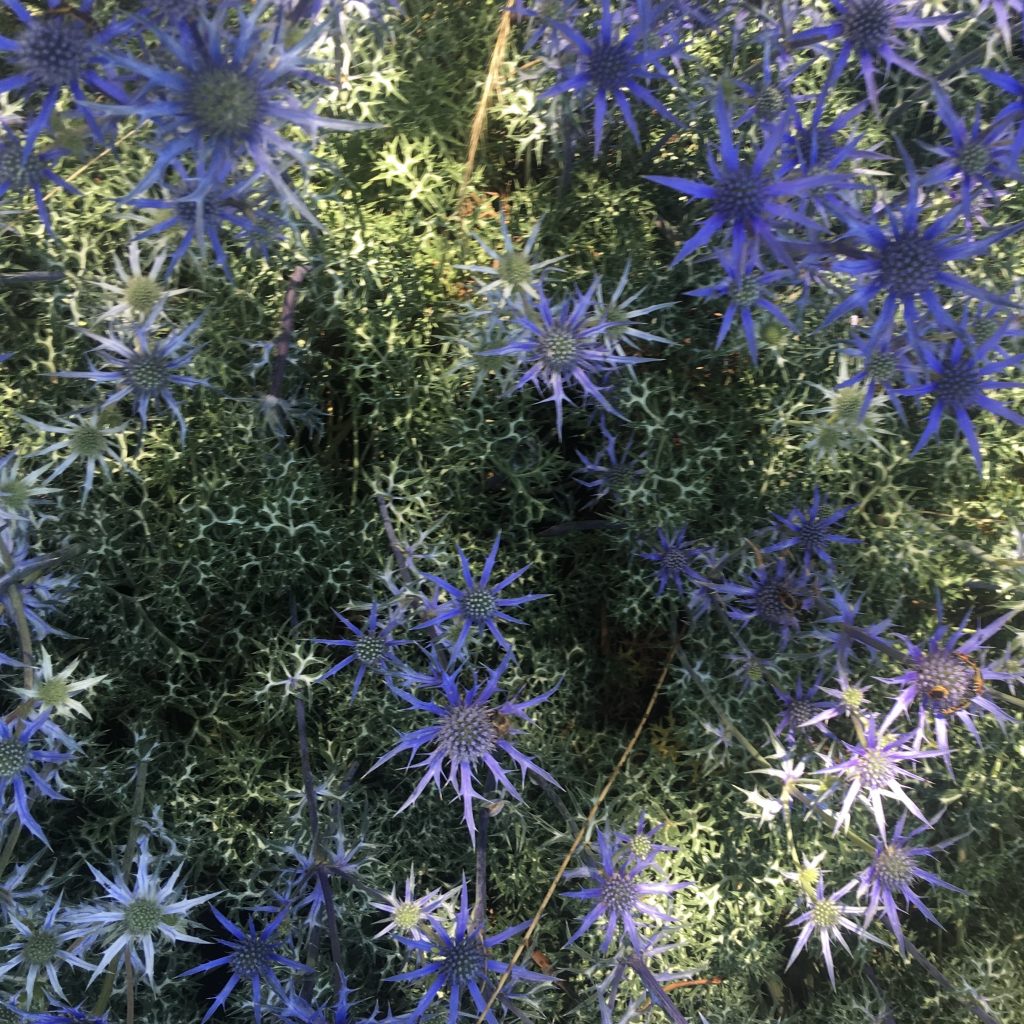
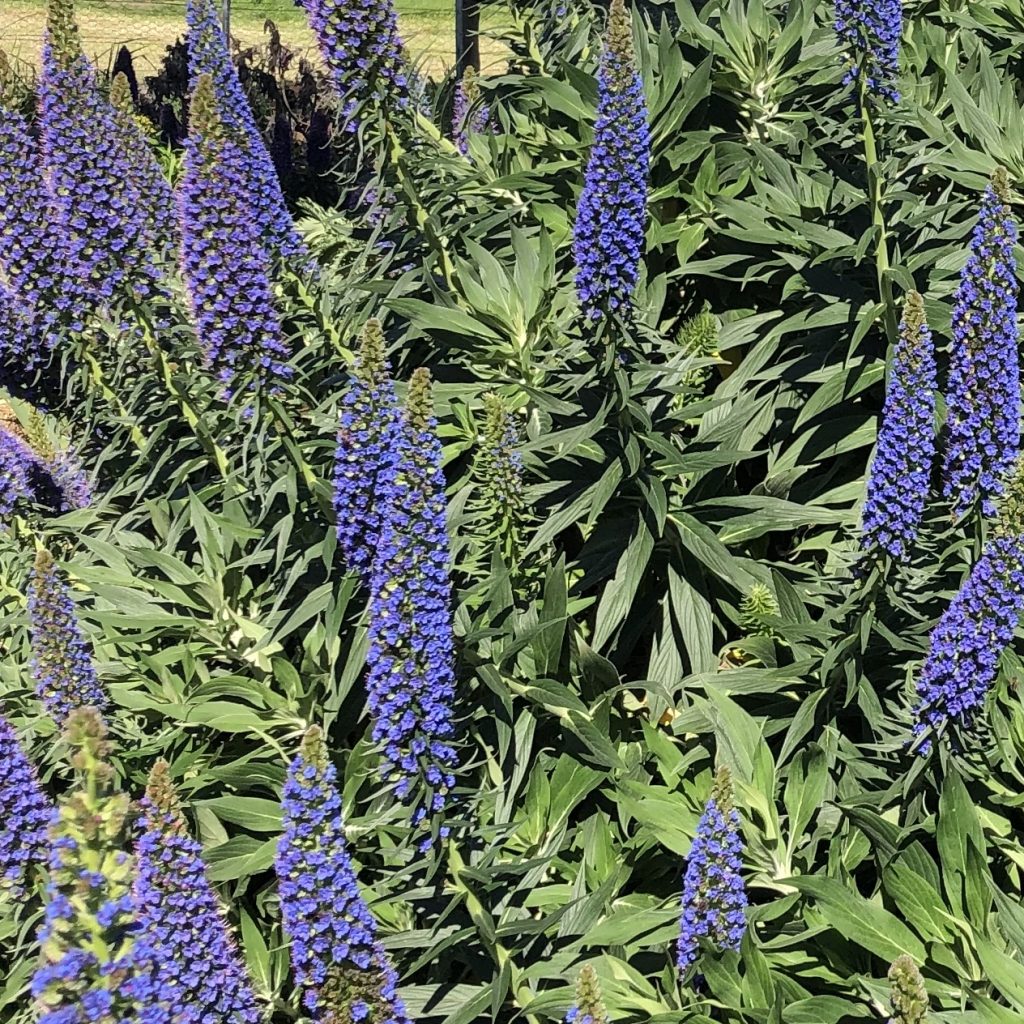
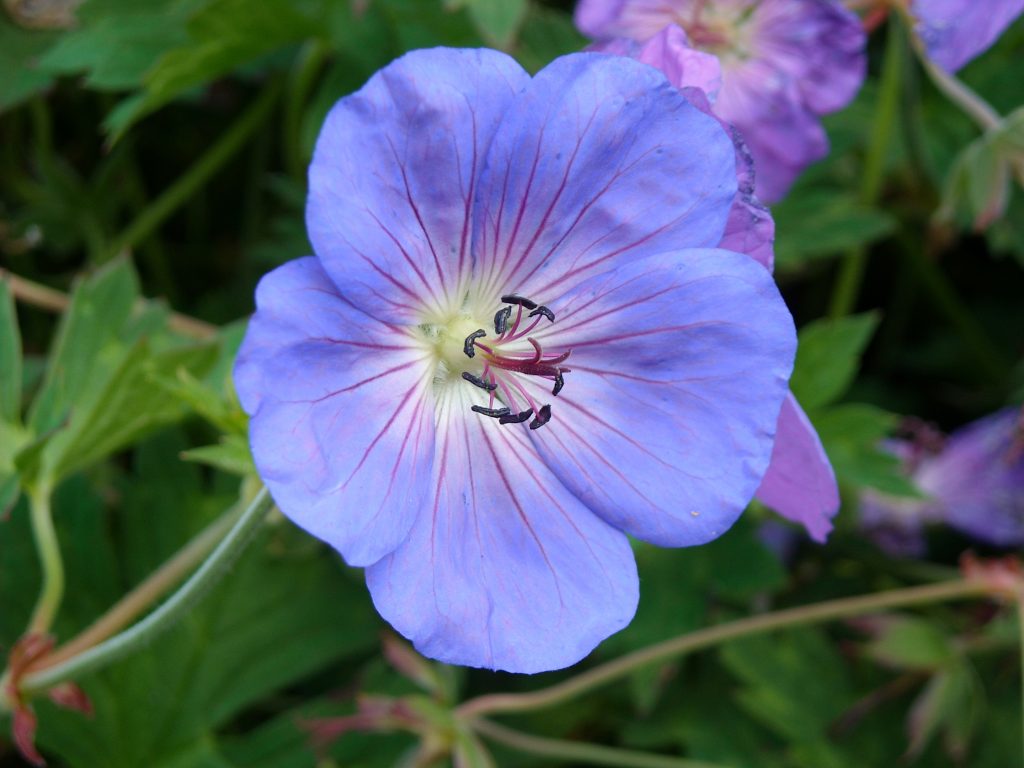
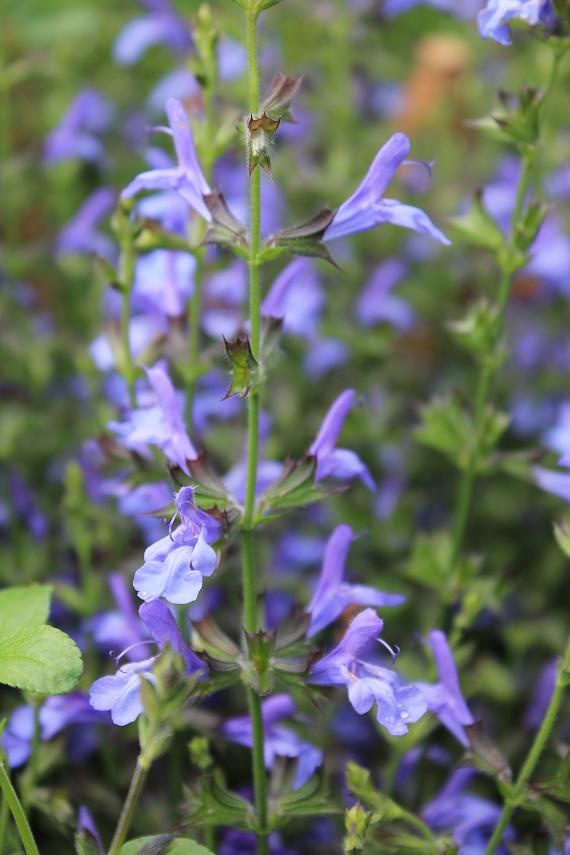
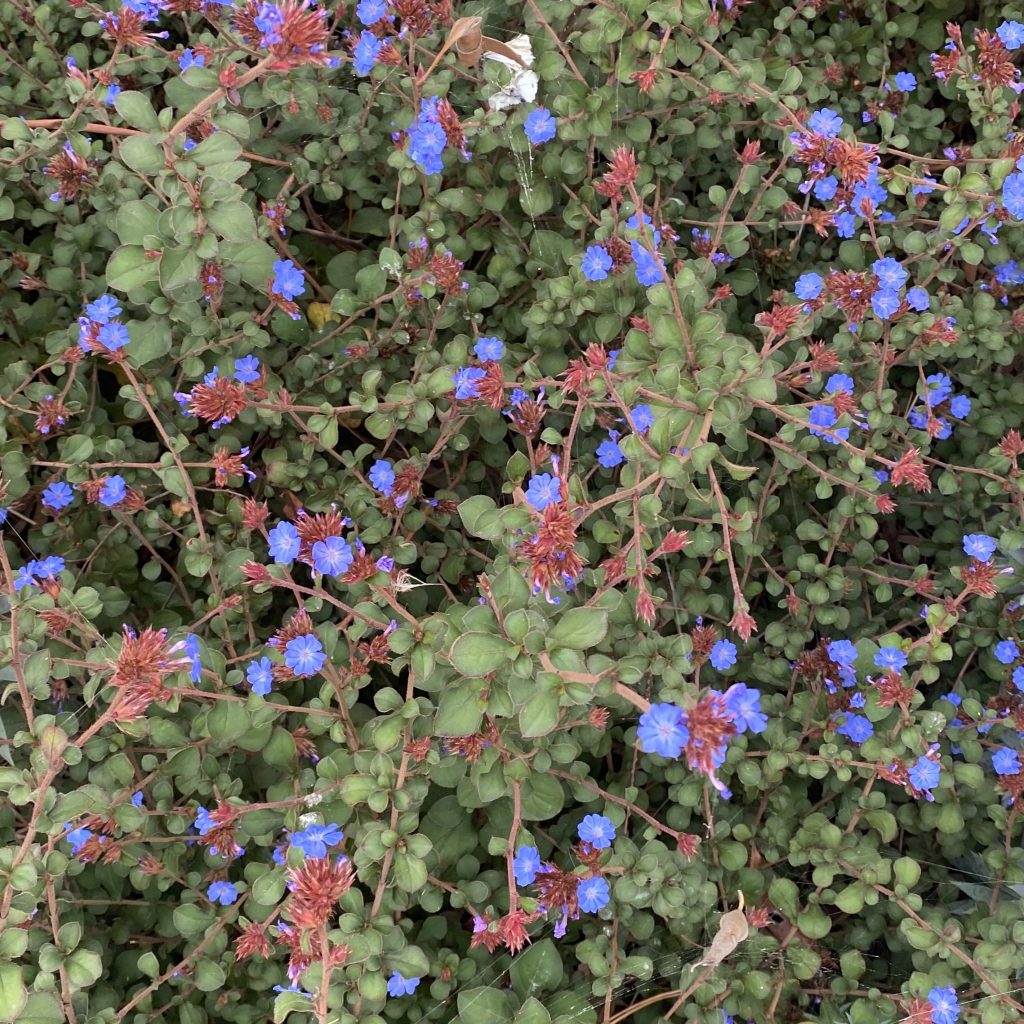
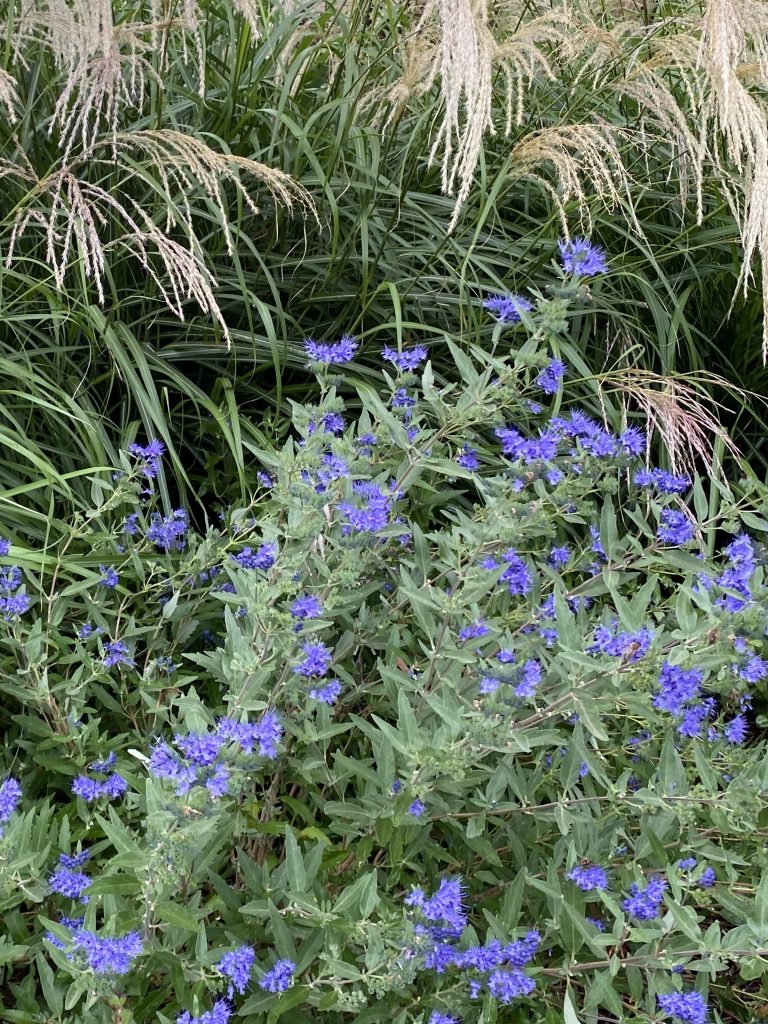
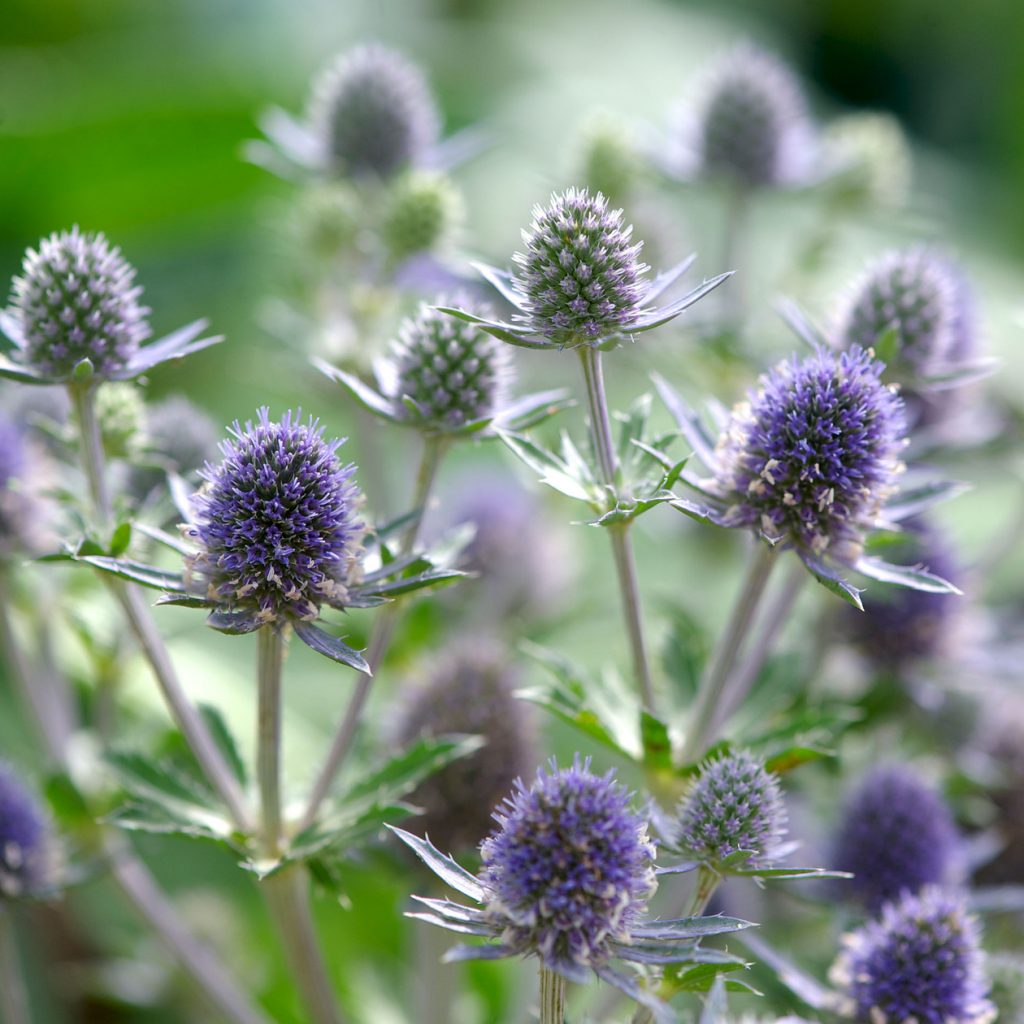
Blue Moon: In the Shade
Blue flowers in the shade can take on an iridescence that is hard to describe. Some favourites are included below. There are also some species that will happily adapt to shadier conditions although will just as happily perform in full sun as well- Ceratostigma plumbaginoides is one dux of this class. The upshot is that it will still flower in the shade, but arguably just not quite as much following the intensity of the first spring flush.
Plants shown top to bottom: 1. Corydalis ‘Pere David’ (photograph supplied by Antique Perennials); 2. Penstemon ‘Blue Springs’ (photograph supplied by Antique Perennials); 3. the classic mop top Hydrangea macrophylla; 4. Pulmonaria ‘Blue Ensigns’ (photograph supplied by Antique Perennials); 5. Omphalodes ‘Cherry Ingram’; 6. Ceratostigma plumbaginoides at Royal Botanic Gardens Victoria.
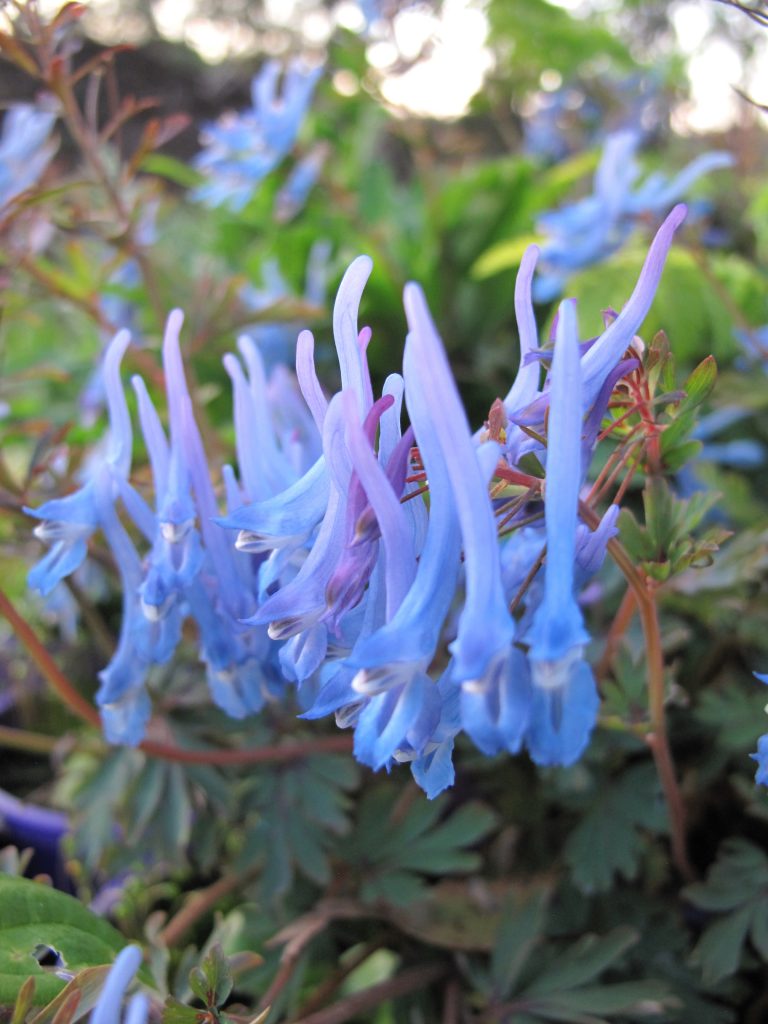
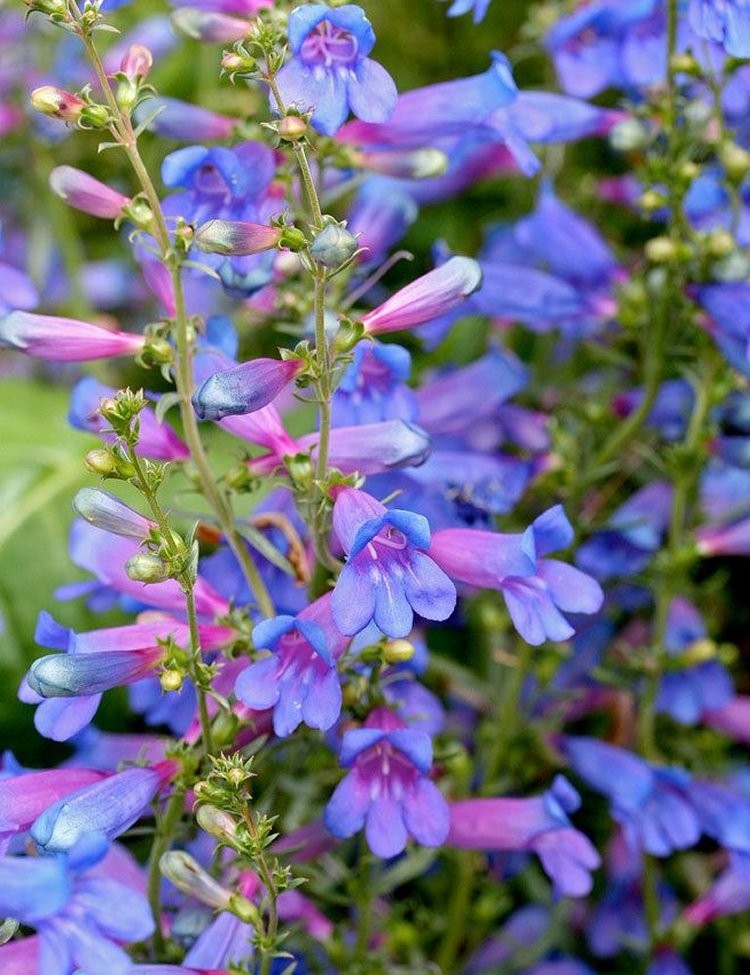

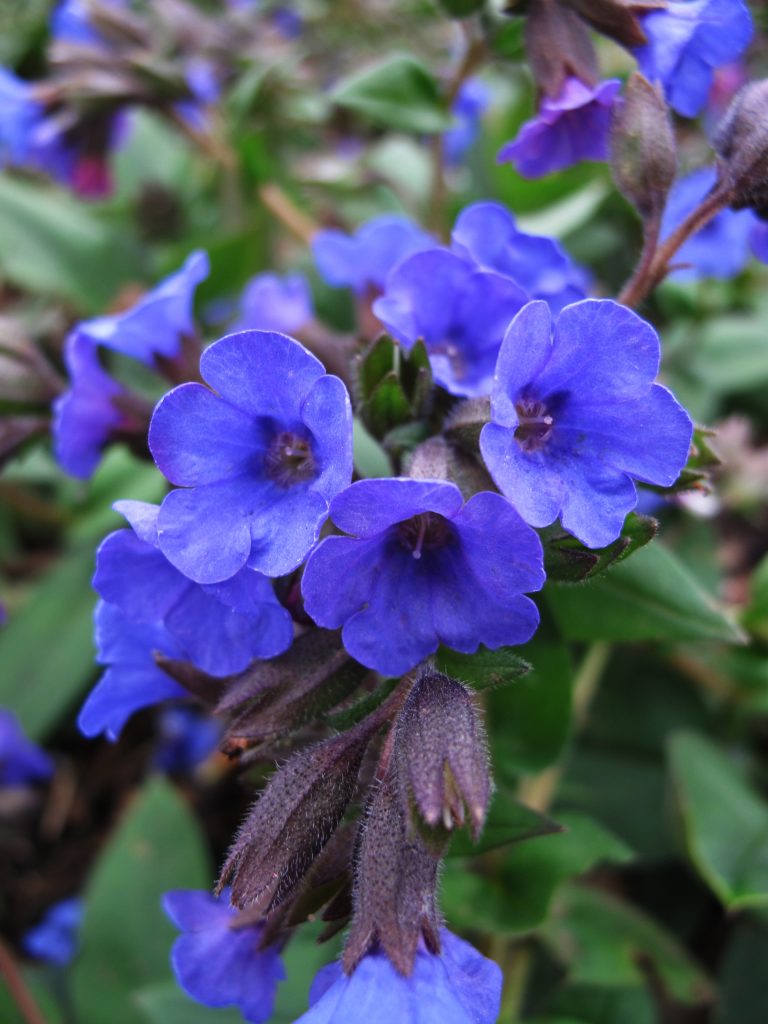
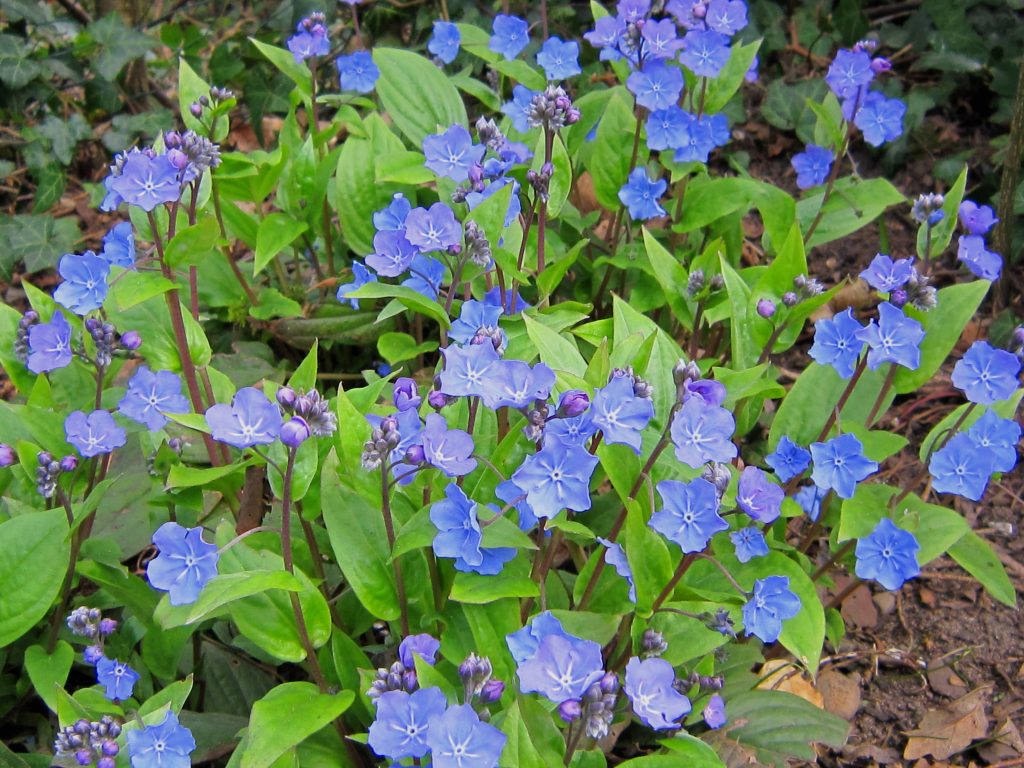
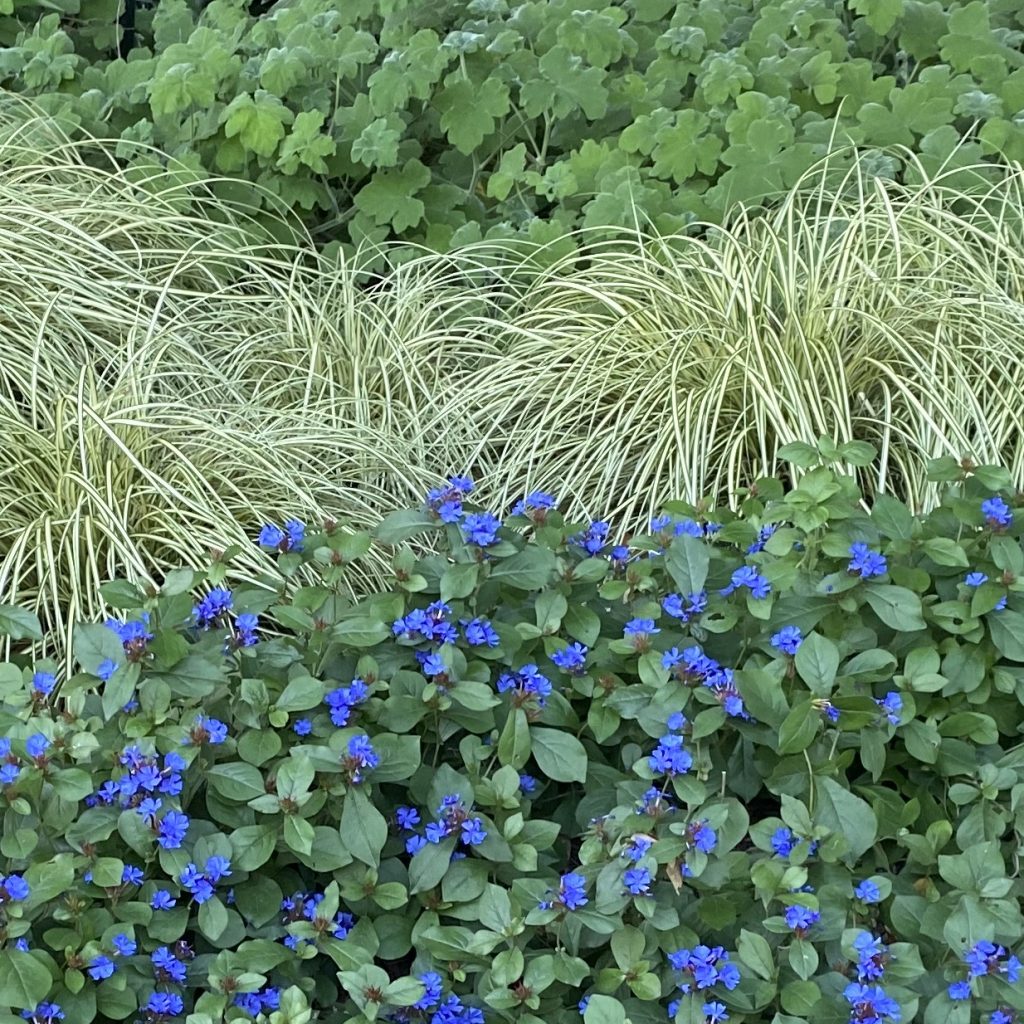
Purple Haze
Sometimes a purple, lilac or lavender blue flowering plant can be used in a blue themed garden unless you are like my client and prefer a more narrow colour spectrum. Lilacs can certainly take on blue hues. Consider how you might use other flowers and foliage to assist in the creation of a theme that amplifies the blues over the lilacs for a deeper and more dramatic effect.
The images below features some great purple, lavender and mauve flowering plants that you might consider for use in your own garden.
From left to right:1. Agapanthus praecox ‘Pallidus’ at Lambley Nursery; 2. Perovskia atriplicifolia on rooftop garden designed by Lisa Ellis Gardens 3. Plectranthus ‘Velvet Elvis’ in garden designed by Lisa Ellis Gardens, 4. Eryngium ‘Tetra Petra’ photo supplied by Antique Perennials; 5. Astilbe ‘Purple Lance’ in garden designed by Lisa Ellis Gardens; 6. Nepeta ‘Walkers Low’ and Stachys byzantina in garden designed by Lisa Ellis Gardens; 7. Wisteria chinensis; 8. Agnus vitex-lucens (Chasteberry)- much under-utilised in this country!; Iris unguicularis (Algerian iris).
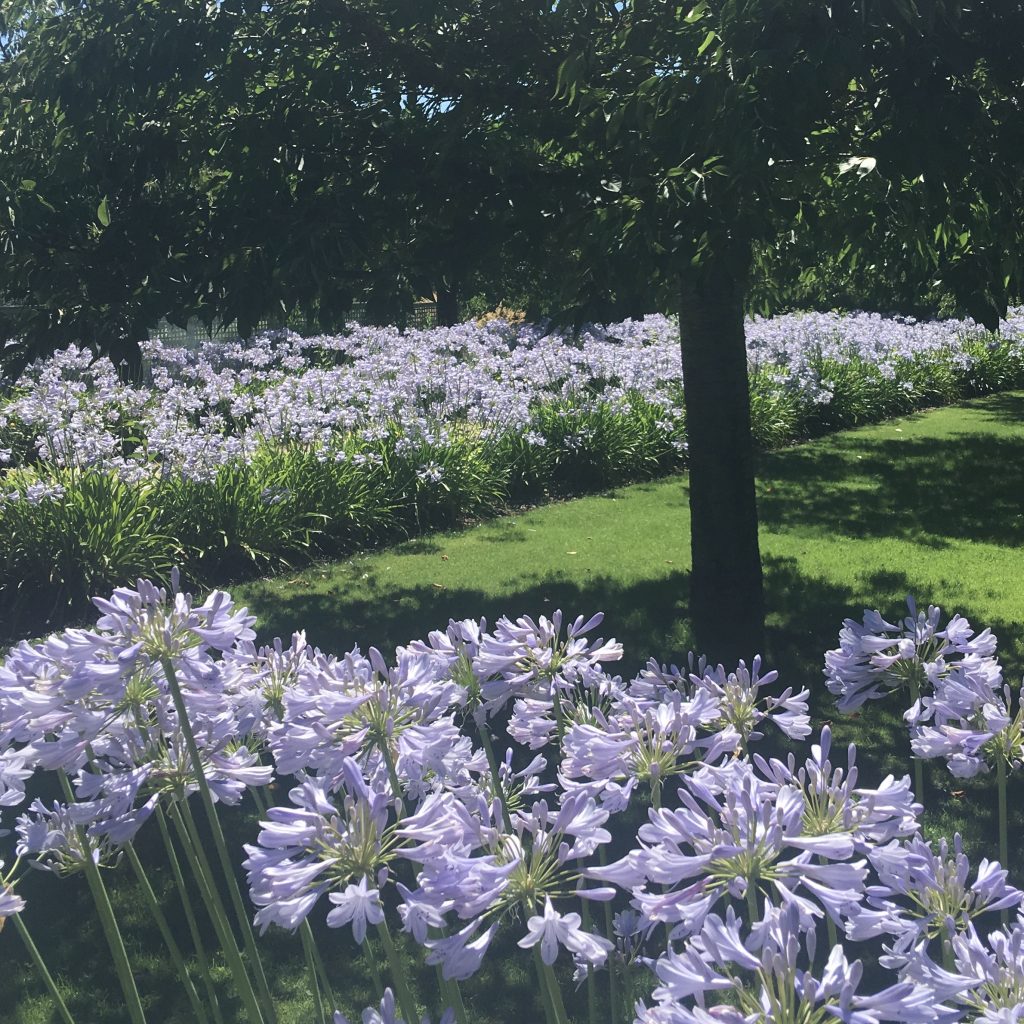
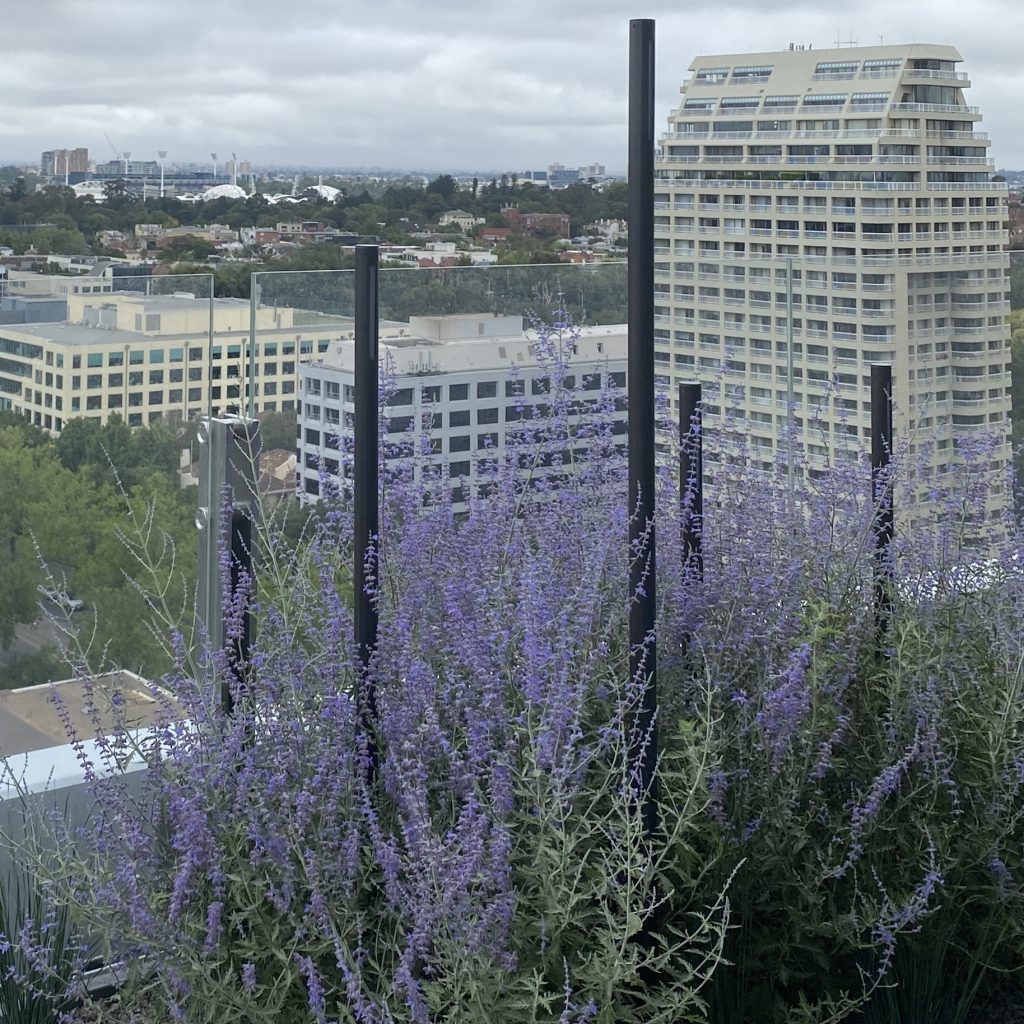
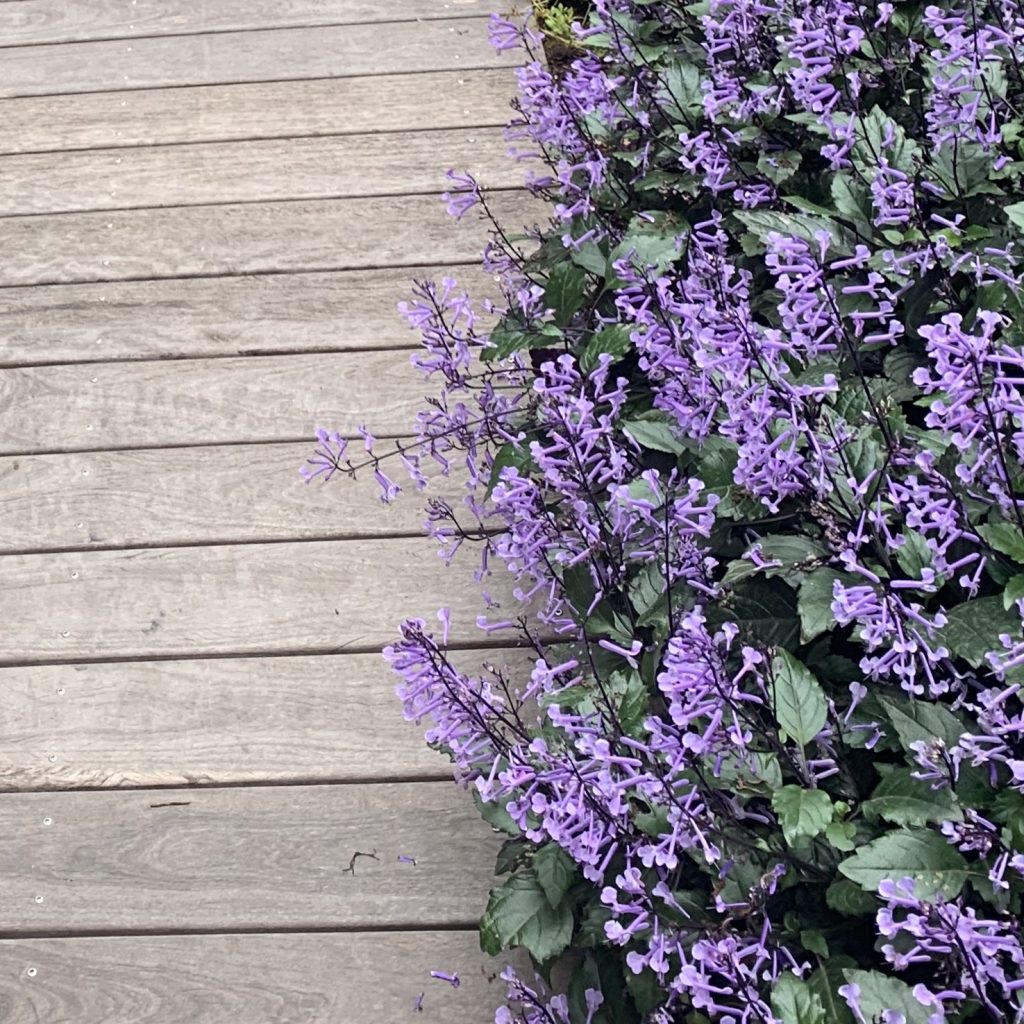
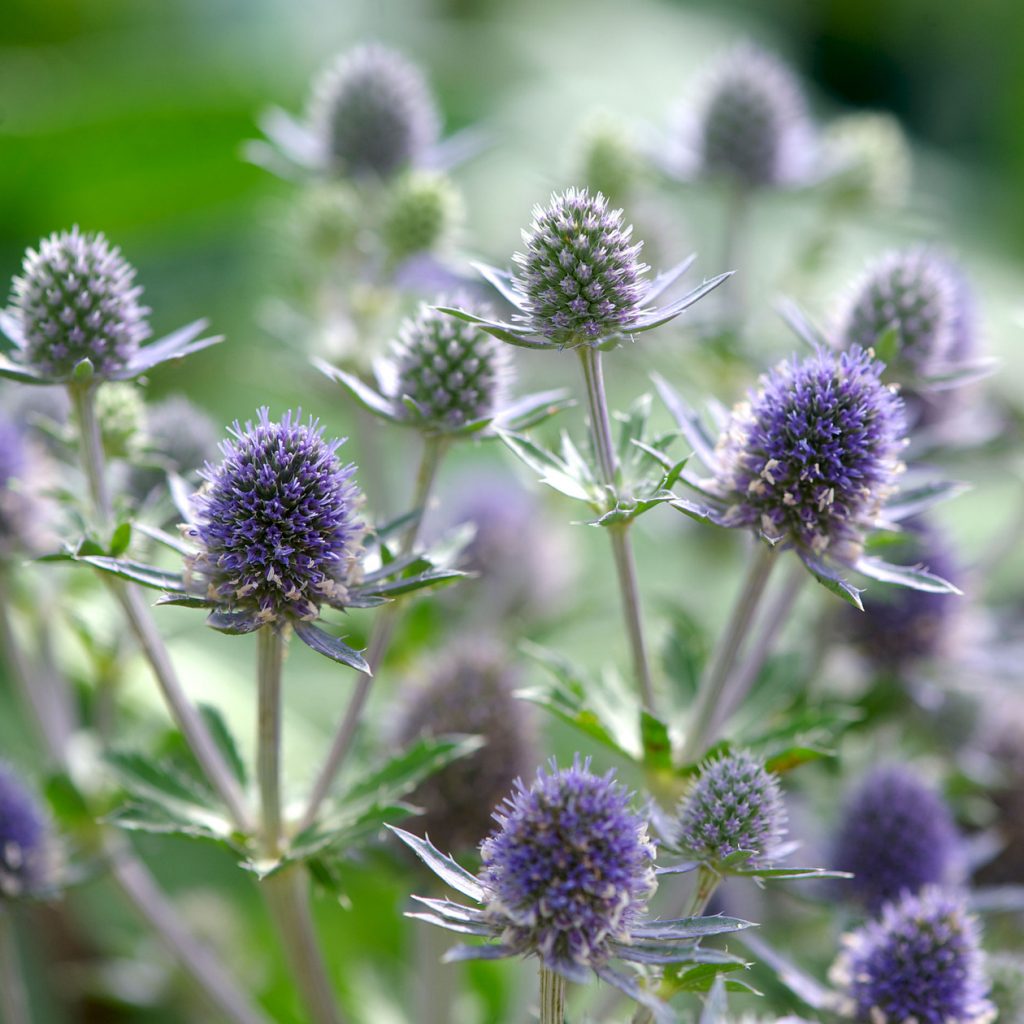
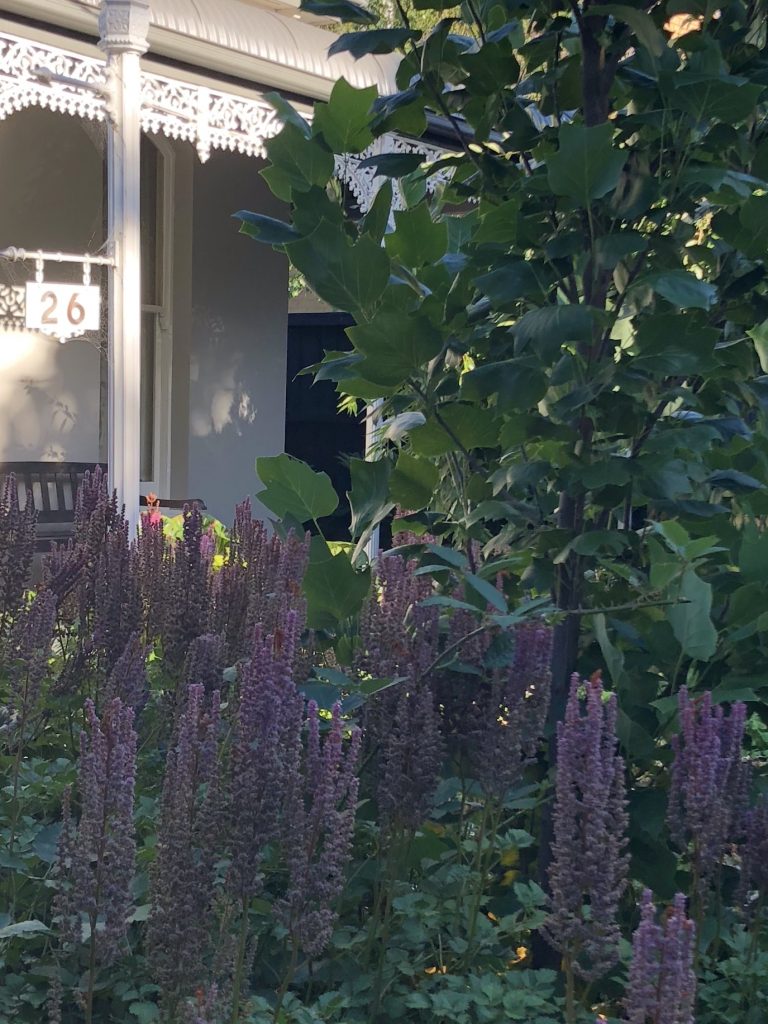
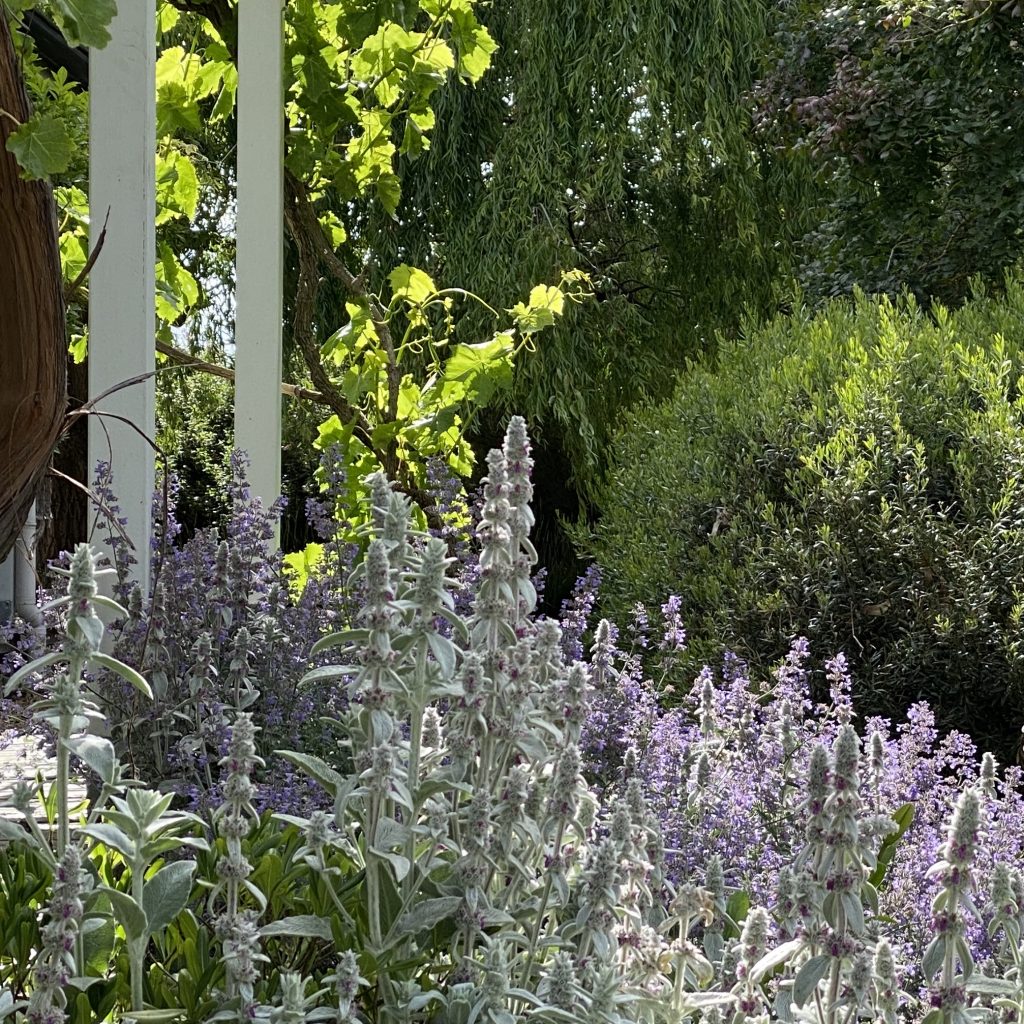
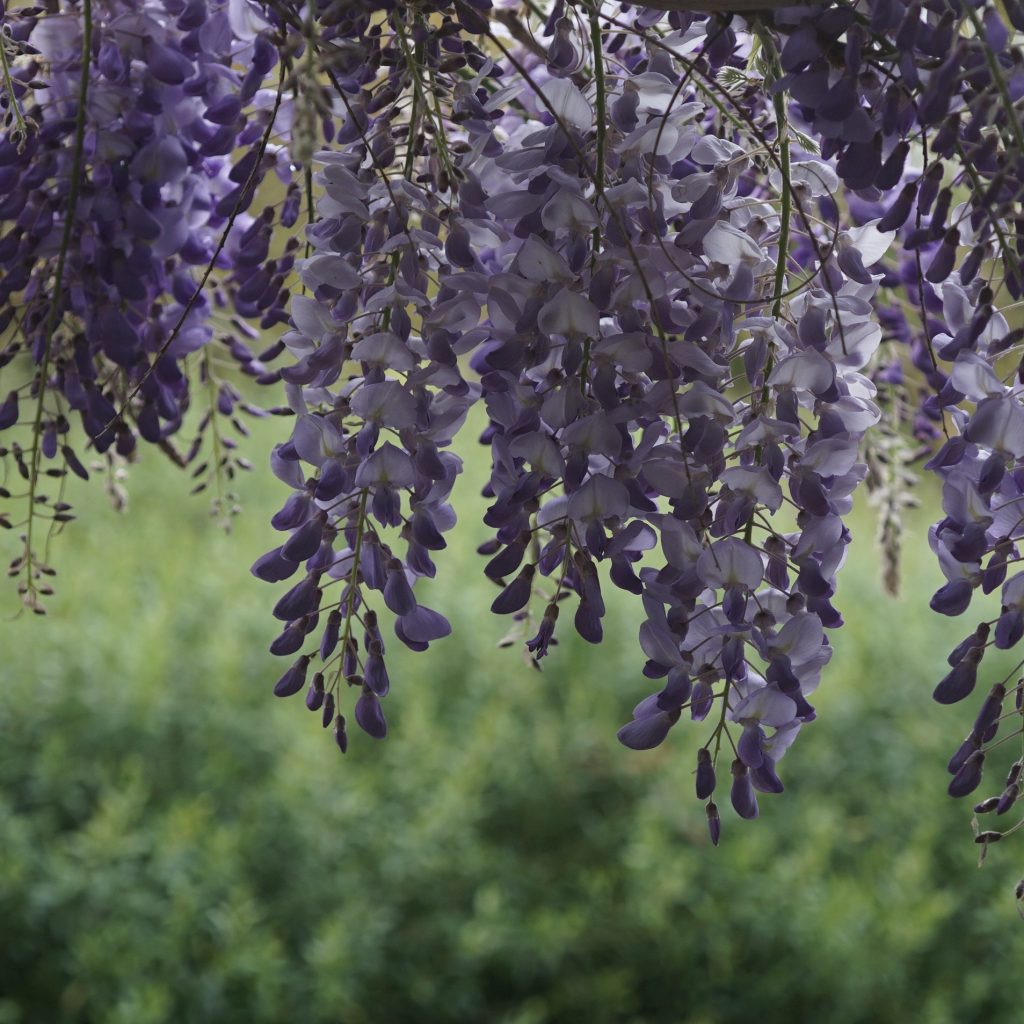
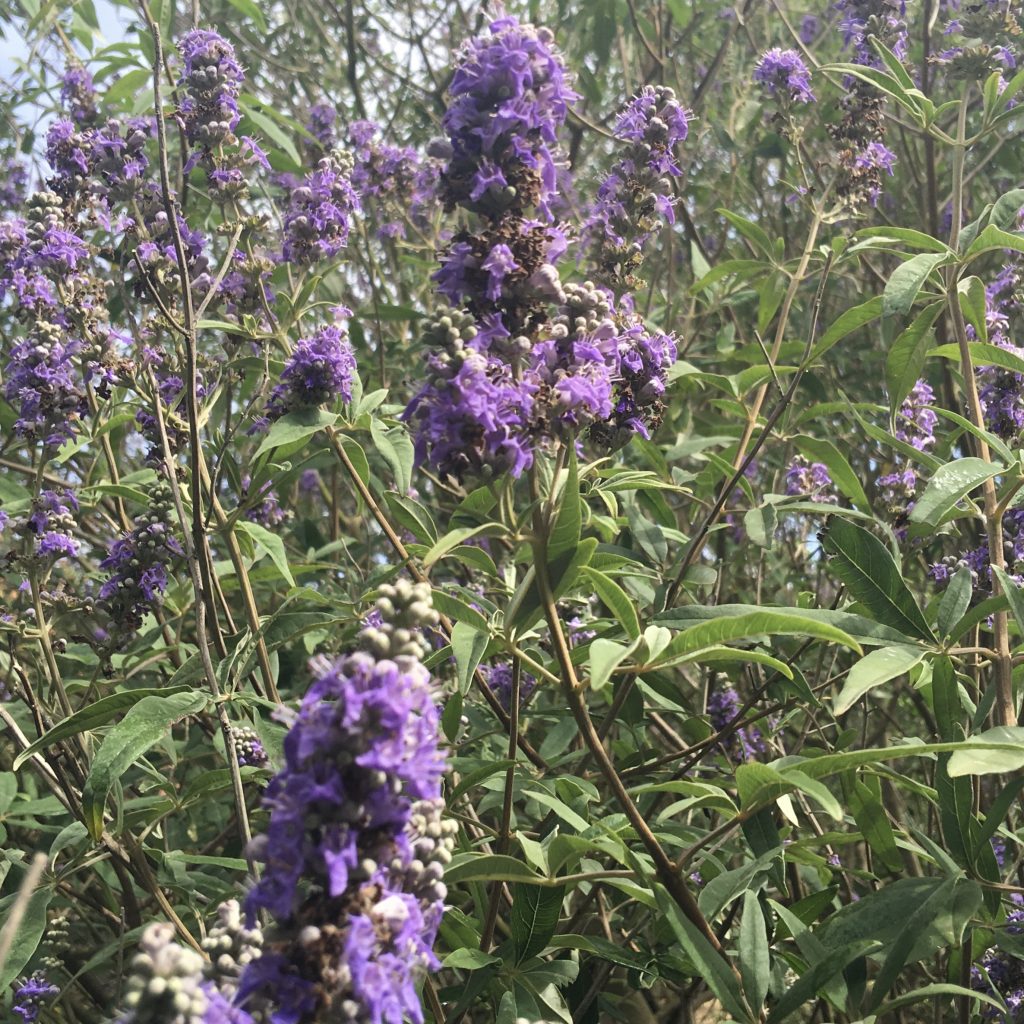
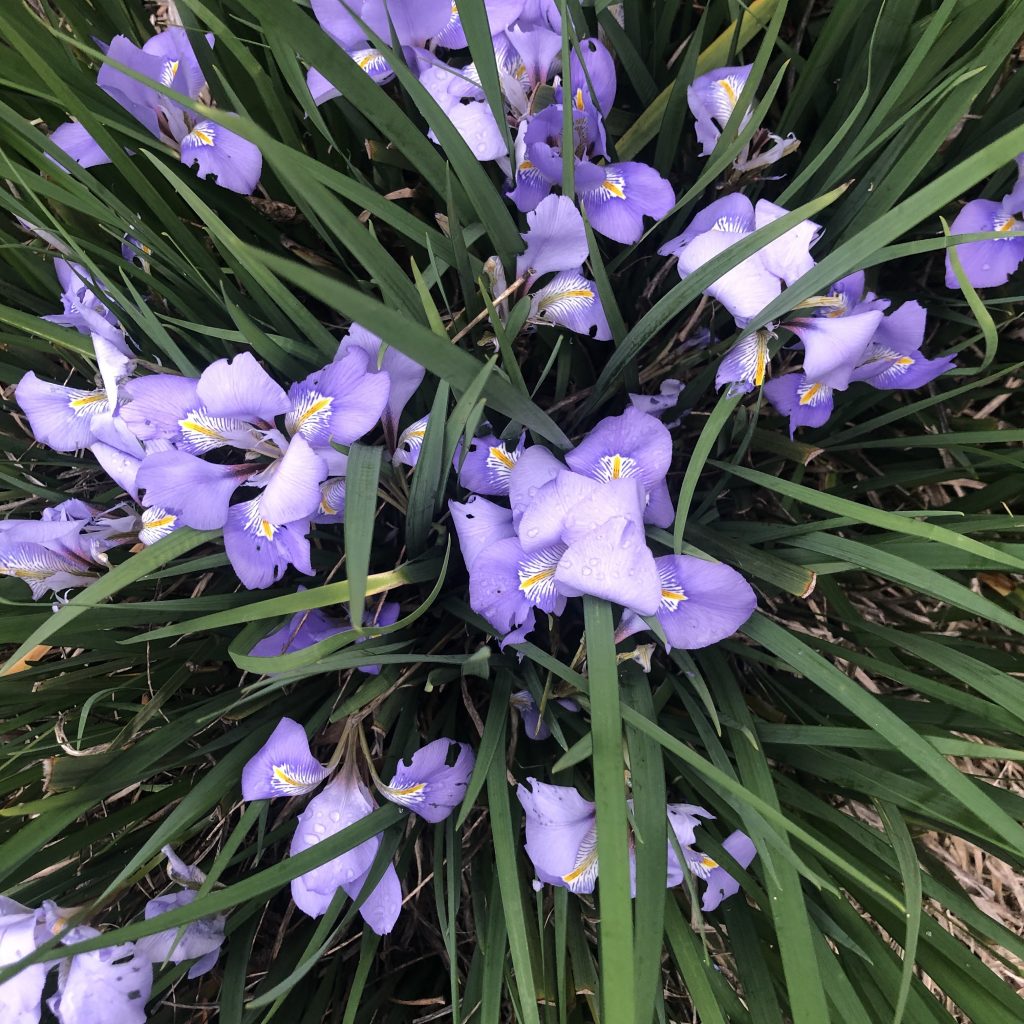
Blue? Purple? Lavender? Lilac? The truth is in the eye of the beholder. And the reality is that to most people it won’t even really matter.
All photos taken by author unless stated otherwise.
Visit your local independent nursery for these plants and other great blue (and purple, lavender and lilac) themed ideas.
Antique Perennial – refer stockists on website
Lambley Nursery: plants available for online order


